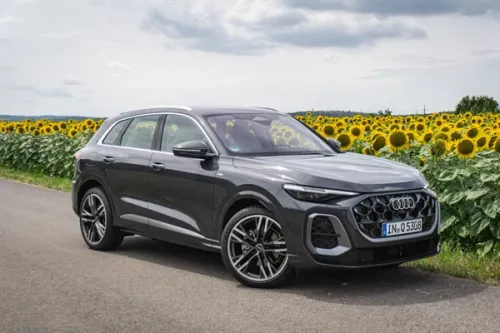This is your life, E60 BMW 5 Series
We bid a fond good bye to the E60 BMW 5 Series as its F10 replacement will make its local debut real soon. We bid a fond good bye to the E60 BMW 5 Series as its F02 replacement will make its local debut real soon.


The fifth generation BMW 5 Series (codenamed E60) was launched during the height of Chris Bangle's design themes and ethos on the Bavarian models when it was launched in 2003.
The previous generation E39 5 Series was certainly a tough act to follow but the E60 broke new ground in many areas. In terms of design, the E60 embodies Bangle's Flame Surfacing cues which included complex convex and concave surfaces as well as flowing transitions from the front and side to the rear - the styling definitely divided opinions during the E60's infancy - I remember watching an early episode of Top Gear where James May actually found it OK but Clarkson absolutely loathed it. Heck, I myself said that the E60 resembled a Proton Waja when viewed directly from the rear! But the styling grew on most critics, myself included. Parked next to the previous generation E-Class, the 5 Series' bitter rival, the E60 certainly looks more purposeful and athletic, especially when fitted with wheels that are at least 18-inch in diameter.
It was not all plain sailing for the E60 in other areas though - the driver oriented interior lacked build quality in early models - I remembered saying back then that the person who designed the retractable cup holders ought to be shot due to its flimsy operation. Storage spaces in front were lacking too - there wasn't any form of cubbyhole or compartment to park a mobile phone. Thankfully, BMW listened to feedback and eradicated these shortcomings by the time the mildly updated version of the E60 appeared in 2007. Another shortcoming was ride quality on early cars - the use of stiff sidewalled run-flat tyres somehow managed to spoil the car's ride and many owners complained of harsh ride quality. For later cars, BMW's chassis engineers altered the car's suspension to cope with the run flat tyres and improve overall ride quality.
Handling and dynamics though, were the E60's biggest draw - no other executive saloon model could come close to the 5 Series, even near the end of its product life cycle in this department. Active Steering was pioneered in the E60. The constantly variable steering rack might need time for most drivers to adjust to but it is certainly beneficial on the road holding front.
Early E60 models introduced here in late 2003/early 2004 made up of the 520i, 525i and the 530i. They were all powered by BMW's silky smooth inline-6 units. Just in case you think, I've made a mistake by saying that the 520i had an in-line 6 instead of a four-pot, early 520i models were powered by BMW's 2.2-litre straight-six while the newer 520is that appeared a couple of years back had four-cylinder motors. The straight-six units though were sweet and a joy to listen to.
The fire breathing M5 appeared in late 2004. The flagship M car had a Formula 1 inspired high revving V10 engine that made 507bhp to see off the likes of Audi's first generation RS 6 and the the Mercedes E55 AMG. Sending the V10's power to the rear wheels was a seven speed SMG II robotized manual gearbox.
The entry-level 520i was replaced by a 523i in early 2005. The 523i basically has the same 2.5-litre straight-six from the 525i but detuned to make 177bhp instead of 192 horses. 2007 saw another update to the car - this time it was more than just engines. The exterior was mildly updated with a slightly tweaked radiator grille, new LED tail lamps and so on. Cutting-edge technologies such as Head-Up Display and BMW Night Vision, Active Cruise Control and Lane Departure Warning were now available as options. The engines too, received upgrades - the 525i now has 218bhp while the 530i saw a power increase to 272bhp from 231bhp. The latter was replaced by the 300bhp 535i a while later. The 520i made another appearance in the local BMW range in 2008 but this time it was powered by a four-cylinder unit.
The E60 5 Series was also transport of choice for officials and delegates attending several high profile events held in Singapore in recent years including the APEC summit, Singapore Airshow and Asian Aerospace, during its lifetime.
From 2005 to 2008, the E60 was the best-selling car in its segment for four years in a row in many markets, with worldwide sales of this model generation amounting to more than a million units by the end of 2007.
I remembered that the first E60 I ever driven was a 525i way back in January 2004. Having recently experienced my last E60 before the F10 rolls in next month, it was highly apt that it was a 525i as well.
A drive in an E60 525i today is once again proof why the 5 Series is the best handling car in its class, even when compared to more modern rivals like the Lexus GS, Mercedes E-Class, Audi A6 and the Jaguar XF, with only the British car coming close to the 5. The 5's steering relays a good amount of feel and feedback to give its driver the confidence to hustle the car quickly on a twisty road. The well-judged suspension controls body roll really well. The 525i I drove rode on big wheels but it somehow offers a much more comfortable and pliant ride quality than earlier E60s I previously had driven.
The 525i's normally aspirated 218bhp straight-six is quite possibly the most charismatic six-cylinder motor around. It is a joy to rev the engine and listen to that in-line 6 purr. BMW's turbocharged straight-six in models like the 335i's might offer more power but it doesn't sound as good as the normally aspirated motors in the 5251 and 530i models. The 525i's motor offers sufficient go in most situations but what the engine is missing is the strong mid-range torque of the turbocharged units.
I also had a go at an oil burning 520d a couple of months back. The entry-level diesel 5 features a four-cylinder turbocharged unit. The four-pot diesel is far from quiet in its operation - it sounds clattery during idling and at slow engine speeds. With plenty of diesel pulling power at low revs though, it was effortless in performance on our urban roads. A good performer the 520d might be, but the 5 Series diesel to have has to be the twin turbo 535d - it has nearly 600Nm of torque on tap.
The late model 525i driven here feels much better built than earlier 5s, especially on the inside. The front cupholders now work seamlessly and don't feel as flimsy as before while the materials and switches feel tactile to the touch. The interior looks modern as well - it helps that BMW hasn't change much how its interior look these days since the E60 was conceived. Admittedly, rear accommodation isn't as good as in the latest E-Class but the driver will appreciate the driver-centric driving environment. Later cars also have the tweaked, newer generation and easier to use iDrive.
On the exterior, Chris Bangle's Flame Surfacing styling still looks modern and contemporary seven years on. In fact, I think that Bangle did best on the 5 and the first generation Z4 during his stay at BMW. The 525i here looks especially good thanks to the big wheels - compare it to the 520d with 16-inch boots and you'll know what I mean.
For those who can't stretch their budgets for a brand new executive model at current crazy COE prices, a used soon-to-be-replaced E60 BMW Series certainly makes for a compelling alternative then.
1972: First-generation (E12)
The E12 was presented at the 1972 Frankfurt Motor Show. The model designation introduced a new concept determining the nomenclature of BMW cars to this very day, with the "5" at the beginning specifying the series as such and the two following numbers indicating the displacement of the respective model.
The E12 stood out from the start through its stretched and sleek lines, large windows and low waistline. As design elements typical of the brand, the dual headlights and the Hofmeister kick in the C-pillar were re-interpreted in new style and technology. This also was when BMW's engineers used superior computer technology, for the first time, to a large extent to calculate the car's deformation zones in the interest of superior occupant safety.
1981: Second-generation (E28)
Accounting for sales of almost 700,000 units, the E12 was a major success. The E28 replacement launched in 1982 then continued this story of success, remaining faithful in its design to the principle of clear lines and large windows.
With its even more striking design front and rear, the E28, despite its exterior dimensions remaining almost identical, offered far greater presence and flair on the road. Engineering refinements and intelligent lightweight technology provided more space within the interior, optimum weight and improved occupant safety. The newly developed suspension with its double-joint front axle and semi-trailing arm rear axle served in particular to enhance the motoring comfort offered by the new model. Modern electronic systems were also introduced into the E28 at this point, ranging from anti-lock brakes via an on-board computer all the way to electronic fuel injection.
The E28 also saw the first M5, which appeared in 1984. The M5 was powered by a 3.5-litre straight-six with up to nearly 290bhp on tap.
When the E28 was replaced after seven years of production, the sales had by then amounted to more than 722,000 units, setting a new record yet again.
1988: Third-generation (E34)
Having introduced the catalyst technology back in 1984, the E34 was fitted from the start exclusively with this high standard of emission management.
With its precisely defined deformation zones and even stiffer passenger cell, the E34 set new standards in the area of occupant safety. Options such as refined suspension with electronically controlled dampers, Servotronic steering assistance and automatic stability control were also made available in addition to ABS.
Compared with its predecessor, the E34 was significantly longer and came with a lot more space inside, also thanks to its brand-new design. Indeed, the new sedan combined sporting elegance and flowing lines with a distinctive wedge shape.
1989 saw the debut of the second generation M5 based on the E34. It featured up to 335bhp from its straight-six. Early M5s were distinguished by their unique alloy wheel design - it had covers on them that mat it looked like it had white wall tyres.
Total sales of the third-generation BMW 5 Series amounted to more than 1.3 million units the world over.
1995: Fourth-generation (E39)
The E39 made its debut at the 1995 Frankfurt Motor Show, offering an evolutionary development through its design of the E34 with its sporting and elegant style. A particular feature at the front was the dual round headlights behind a glass cover, with the light rings for the positioning and daytime driving lights so typical of BMW being added in the year 2000.
The sedan which was introduced in 1997 offered even more space within the passenger compartment. Boasting features such as a multifunction steering wheel, a navigation system, active seats and Dynamic Stability Control, the E39 was acknowledged as a particularly outstanding high-tech representative of its segment. In the interest of enhanced driving dynamics and safety, the body came with a significant increase in torsional stiffness over the former model, and the E39 was the first large-scale production car worldwide made almost completely of light alloy. The newly developed all-aluminium engines also helped to significantly reduce the weight of the car.
For the first time, V8 engines were available in the 5 Series with the E39 540i and M5. The latter offered a highly tuned bent eight with a whopping 400bhp, making the M5 one of the fastest and most desirable performance saloons at that time.
The E39 once again broke sales record by accounting for 1.47 million units sold up to the end of production in early 2004.

Sales of the BMW 5 Series already amount to more than 5.5 million units in five model generations - and now a new chapter is starting in the highly successful story of the BMW 5 Series Sedan.
The world debut of the F10 once again marks the epitome of aesthetic design and supreme driving pleasure in the upper midrange segment. With the longest wheelbase in the segment, a long and sleek engine compartment lid, short overhangs front and rear and a coupé-like, graceful roofline, the F10 stands out in the executive segment.
Overall, the aesthetic looks of the car are clearly determined by perfectly balanced proportions. Within the interior, modern function and a superior ambience come together in perfect harmony, unmistakable style and clear orientation to the driver in the cockpit guaranteeing a truly unique driving experience.

The F10's advanced drivetrain and suspension technologies ensure supreme sportiness and an even higher standard of motoring comfort all in one. At the same time optional Dynamic Driving Control enables the driver to set the suspension individually to his personal requirements. The F10 is available with Adaptive Drive encompassing Dynamic Damper Control and Dynamic Drive stability control, as well as BMW's Integral Active Steering.

Through its sporting and elegant looks, driving dynamics typical of the brand, outstanding efficiency as well as innovative comfort and safety features, this sixth generation of BMW's executive express convincingly reflects the supreme standard of the world's most successful premium auto maker and looks set to continue the successful legacy set by the BMW 5 Series for the years to come.
The F10 will be launched in Singapore in May.

Credits: Story by Raymond Lai Photos by BMW and Raymond Lai


Get the Best Price for your used car
from 500+ dealers in 24 hours

- Convenient and Hassle-Free
- Consumer Protection
Transparent Process
With No Obligation








